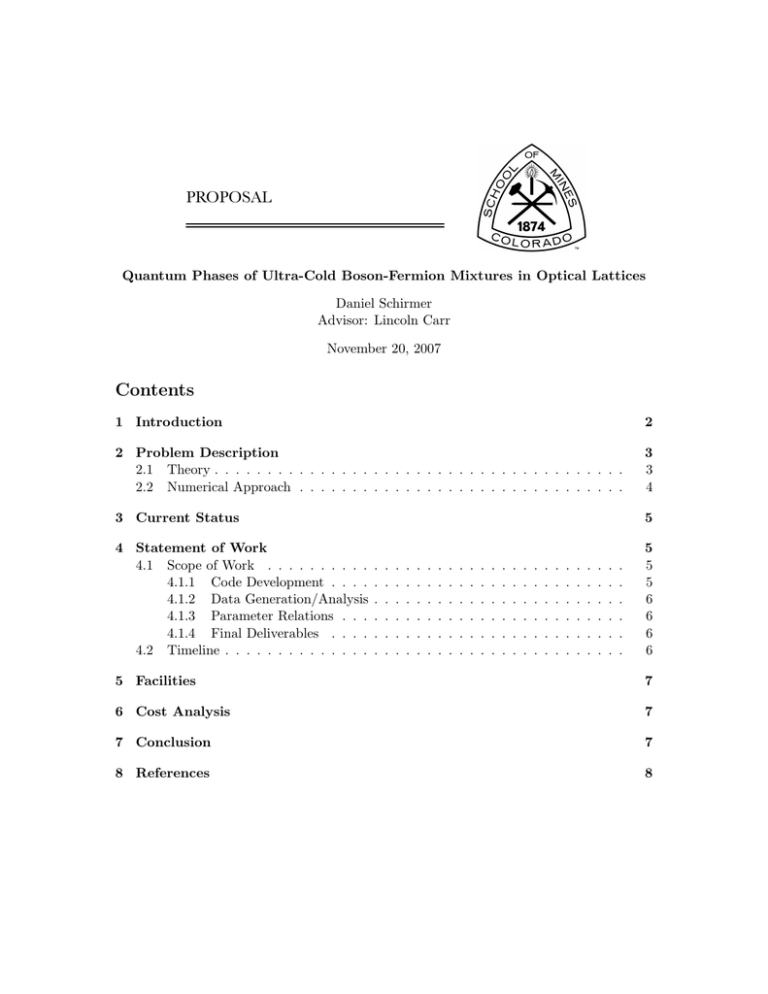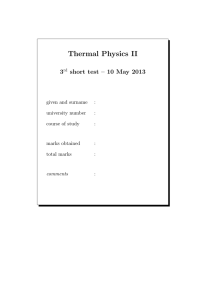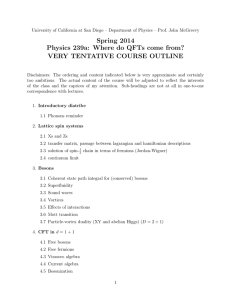PROPOSAL
advertisement

PROPOSAL
Quantum Phases of Ultra-Cold Boson-Fermion Mixtures in Optical Lattices
Daniel Schirmer
Advisor: Lincoln Carr
November 20, 2007
Contents
1 Introduction
2
2 Problem Description
2.1 Theory . . . . . . . . . . . . . . . . . . . . . . . . . . . . . . . . . . . . . . .
2.2 Numerical Approach . . . . . . . . . . . . . . . . . . . . . . . . . . . . . . .
3
3
4
3 Current Status
5
4 Statement of Work
4.1 Scope of Work . . . . . . . . . .
4.1.1 Code Development . . . .
4.1.2 Data Generation/Analysis
4.1.3 Parameter Relations . . .
4.1.4 Final Deliverables . . . .
4.2 Timeline . . . . . . . . . . . . . .
.
.
.
.
.
.
.
.
.
.
.
.
.
.
.
.
.
.
.
.
.
.
.
.
.
.
.
.
.
.
.
.
.
.
.
.
.
.
.
.
.
.
.
.
.
.
.
.
.
.
.
.
.
.
.
.
.
.
.
.
.
.
.
.
.
.
.
.
.
.
.
.
.
.
.
.
.
.
.
.
.
.
.
.
.
.
.
.
.
.
.
.
.
.
.
.
.
.
.
.
.
.
.
.
.
.
.
.
.
.
.
.
.
.
.
.
.
.
.
.
.
.
.
.
.
.
.
.
.
.
.
.
.
.
.
.
.
.
.
.
.
.
.
.
5
5
5
6
6
6
6
5 Facilities
7
6 Cost Analysis
7
7 Conclusion
7
8 References
8
1
Introduction
Both theoretical and experimental studies of cold atoms are expanding rapidly [1, 2, 3, 4, 5, 6]
and are of widespread interest and application to a variety of fields including solid-state physics
[2], and quantum information [3]. The recent experimental realization of a BEC (Bose-Einstein
condensate) has stimulated research in other cold atomic gasses such as those involving fermions
[4, 5]. Systems can now be created in laboratory conditions that subject these quantum gasses
to periodic potentials known as optical lattices. The optical nature of these potentials provides
unprecedented control and precision over the lattice by varying parameters such as lattice height
(optical intensity) and node spacing (wavelength). Cold atomic systems display a wide variety of
exotic dynamics where quantum attributes are showcased macroscopically.
The tunability of a lattice-based quantum system heightens its appeal for several reasons. One
example is that many sold-state systems may be simulated using ultra-cold atoms in optical lattices.
The tunability of the lattice potential and other particle-related quantities provides an experimental
playground for solid-state and atomic/molecular/optical physicists. Instead of having to create a
new material in order to study its interesting crystal structure, a hypothetical material may be
investigated using cold atoms in an optical lattice.
We plan to conduct a numerical exploration of the Fermi-Bose Hubbard model as proposed by
[6] with the quantum-mechanical description of a many-body system known as second quantization. This model provides a theoretical approach to the cold atom systems described above. We
employ a specialized numerical algorithm to actively reduce the dimensionality of an otherwise
intractably large Hilbert space to compute the system’s time-evolved state [7,8]. An efficient theoretical implementation of this model will serve to simulate the dynamics and predict the properties
of ultracold quantum gas systems created in current experiments. Finally, we intend to produce a
manuscript in response to [6].
2
2
2.1
Problem Description
Theory
We solve the following single-band Fermi-Bose Hubbard hamiltonian (FBHH) for a 1-D
lattice system [6]
H = Hf + Hb + H f b
X †
X
1 X b b
Hb ≡ −tb
(bi bj + bi b†j ) + Ub
ni (ni − 1) − µb
nbi
2
i
hi,ji
X
Hf ≡ −tf
hi,ji,s
Hf b ≡ g
X
i
(1)
(2)
i
X f
1 X f f
†
†
ni↑ ni↓ − µf
nis
(fis
fjs + fis fjs
) − Uf
2
i
Uf b X b f
† †
ni nis
(b†i fi↑ fi↓ + bi fi↓
fi↑ ) +
2
(3)
i,s
(4)
i,s
for ground states in a non-number-conserved Fock basis. Hf is the standard Hubbard
Hamiltonian for fermions, and Hb is the Bose-Hubbard hamiltonian. Hf b is a hamiltonian
that contains all interactions between fermions and bosons, including a conversion term,
allowing bosons and fermions to both pair and dissociate. We choose a local Hilbert space
of dimension 4 × dB , where 4 is the local space for fermions (|0i, | ↑i, | ↓i, and | ↑↓i) and
the space of dimension dB allows up to dB − 1 onsite bosons (|0i, |1i, ... |dB − 1i). The
complete system’s space is of dimension (4dB )n , where n is the number of sites.
The parameters are as follows: tb and tf are the tunneling energies for bosons and fermions,
respectively. Uf , Ub , and Uf b are interaction energies. µb and µf are chemical potential
terms, representing the energy cost/gain in adding/removing a single particle to the system. g is the pairing energy, and allows bosons and fermions to become interchangeable in
the lattice due to the BEC/BCS crossover. Subscripts i and j are site indices, and hi, ji
indicate neighboring sites. The subscript s sums over Fermi spin states, where s ∈ {↑, ↓}.
bi and b†i are the boson destruction/creation operators on site i. Similarly for fermions:
†
fi and fi† . nf and nb are the number operators for fermions and bosons; nfis = fis
fis and
nbi = b†i bi .
Because we do not allow a second energy band, the onsite interaction energies (Uf , Uf b )
must be much smaller than the band gap energy.
Once the system is numerically solved for a given set of parameters (this problem is not
generally solvable analytically), we must make some measurement of the system to extract the most pertinent information from the groundstate. These measurements of the
3
groundstate are plotted as functions of varied hamiltonian parameters to generate phase
diagrams. These diagrams will be used to confirm analytic predictions for some limiting
cases in [6], as well as to gain insight into the unique characteristics of a coupled BoseFermi system. As an example, we provide a plot of average filling (total particle number,
divided by the number of sites) for uncoupled bose and fermi systems where the unitless
parameters J = tb = tf and µ = µb = µf are normalized by U = 1 (Figure 1).
Bosonic
System
N"Ave"B
Fermionic
System
N"ave"F
1.0
µ
1.0
µ
0.8
0.6
0.4
1.59916
0.6
2.
0.4
N_Ave = 1
0.2
0.2
0.0
!9
0
2.68262 10
!0.2
!0.4
0.00
0.8
N_Ave = 1
0.0
!9
0
5.36524 10
!0.2
!0.4
0.05
0.10
0.15
0.20
0.25
0.00
J
0.05
0.10
0.15
0.20
0.25
J
Figure 1: Example phase diagram of average number versus hopping and chemical potential. Data was generated by Fortran Bose-Fermi code with coupling turned off. 5 sites.
Diagrams match accepted results for bosonic and fermionic systems, suggesting functional
code.
We have presented 8 parameters in the FBHH (tf , tb , µf , µb , Uf , Ub , Uf b , and g), yet want
to explore the parameter space as efficiently as possible. To accomplish this, relations
between dependent parameters must be calculated to reduce the space of free parameters.
Only then can we generate truly accurate and experimentally useful predictions about the
system. We will discuss this in more detail later.
2.2
Numerical Approach
Because the FBHH requires a discrete, complex Hilbert space whose dimensionality grows
n
exponentially (H = C(4dB ) ), where n is the number of sites in the lattice and dB is the
local boson dimension, measures must be taken to analyze a particular state, choose an
optimal truncated space of some preset finite dimension, and project the state into the
4
new basis. We employ a time-evolving block decimation algorithm using imaginary time to
accomplish this task [7,8]. Our collaborators have made excellent progress in implementing
this somewhat involved algorithm into FORTRAN code for simple lattices containing only
bosons.
3
Current Status
In the past 5 months, excellent progress has been made in extending the Fortran code
to include functionality for a lattice containing fermions. I successfully implemented time
propagation and measures to solve purely fermionic systems described by the Hubbard
model. This code was tested, and it and compared favorably with accepted results.
Secondly, groundwork was laid for efficient phase diagram generation in both the Fermi
and Bose systems. This process involved designing an ASCII data formating standard
and implementing input/output routines for these data files in FORTRAN and Mathematica, which is being used to generate graphics from the data. We now have an automated
process which is used to transfer and compile data into useful diagrams, and store them
automatically with useful titles and full calculation information including runtime, numerical parameters, and system parameters.
Implementation for the mixed Bose-Bermi system has been in development for the past 3
months and is nearing completion. We are undergoing final test runs and implementing
final quantum measures in the FBHH. An example calculation using this code is shown in
Figure 1.
4
Statement of Work
4.1
Scope of Work
Here we outline the major tasks that will be completed by the end of the year (May, 2008).
4.1.1
Code Development
Code development is a current focus of this project. Before using the numerical algorithm,
we must ensure its accuracy by comparing test cases with known results. Also, we are
working to implement a wide range of system measures to be applied on the groundstate
(number, energy, and entanglement properties).
We will also develop a parallel version of the code using MPI. Since this code is run
on a cluster with hundreds of nodes, computation time (which is on the order of days for
large diagrams) may be reduced tremendously.
5
4.1.2
Data Generation/Analysis
Once the algorithm is both implemented and trusted, we will begin running many calculations at once, to calculate a high resolution groundstate portrait of the parameter space in
terms of the measures mentioned above. Depending on the results of these calculations, we
will investigate any interesting cases we may find, as well as compare analytic predictions
to numeric ones for limiting cases.
4.1.3
Parameter Relations
A highly analytic portion of the project includes calculating how dependent parameter
values in the hamiltonian will be related to one another in the context of a typical laboratory
system. Experimentally relevant parameters will allow us to not only make qualitative
inferences about the FBHH, but also to make precise comparisons with experimental data
and reduce the working parameter space.
4.1.4
Final Deliverables
Near the end of the project, extra time must be spent to generate final deliverables. These
include a manuscript for submission to an APS journal and the final report for senior
design.
4.2
Timeline
Our estimated project timeline is shown in Figure 2.
Fall Semester
Spring Semester
code testing/debugging
code parallelization
Winter Break
data generation
analyze data
parameter relations
prepare manuscript
finalize and submit manuscript
prepare final report/presentation
6
8
,0
ay
M
08
n,
Ja 7
,0
ec
D
nt
rre s
Cu tatu
S
7
0
g,
Au
Figure 2: Estimated Project Timeline
5
Facilities
The FORTRAN code for this project is both written for and executed on the National
Institute for Standards and Technology (NIST)’s computer cluster. As a collaborator at
NIST, I have access to the cluster and will continue to run all calculations remotely on the
system.
6
Cost Analysis
The projected cost of this project is $0. The cost of computation is significant but is covered
by federal grants that support the computer systems at NIST in Gaithersburg MD where
I am privileged as an offsite collaborator. The cost of local post-processing is negligible, as
all necessary software (Mathematica) has already been purchased. Office supplies are also
a negligible expense.
7
Conclusion
Numerical treatment of the Hubbard and Bose-Hubbard models have been very successful
in the past. Our goal, which is to incorporate both models simultaneously, is a natural
follow-up that has not yet been explored. This project shows promise in discovering new
and exciting physics as it contributes to cold atom theory. I await your permission to
proceed.
7
8
References
[1] M. Greiner et al., Nature 415, 39, (2002)
[2] K. Alexander and J. Dieter, Phys. Rev. A 73, 053613 (2006)
[3] A. Griessner et al., Phys. Rev. A 72, 032332 (2005)
[4] G. Modugno et al., Phys. Rev. A 68, 011601 (2003)
[5] R. Roth and K. Burnett, Phys. Rev. A 69, 021601 (2004)
[6] L. Carr and M. Holland, Phys. Rev. A 72, 031604 (2004)
[7] G. Vidal, Phys. Rev. Lett. 91, 147902 (2003)
[8] G. Vidal, Phys. Rev. Lett. 93, 040502 (2004)
8


